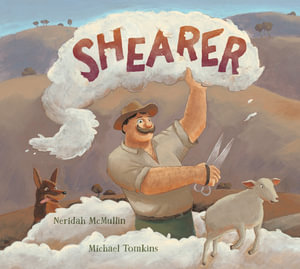Shearer by Neridah McMullin and Michael Tomkins

The earthy sepia toned colours used in the inviting illustrations, set the background for the hot sweaty work in shearing sheds found all over outback Australia. The use of the blade shears was supplanted by mechanised shears introduced in the late nineteenth century and these were passed over for more recognisable equipment used by shearers today.
Jack Howe is a giant of a man with hands like tennis rackets, and blades that seemed like extensions of his arms.
People can only watch him as he shears his way through a large complement of sheep each day. Most people shear about 100 sheep per day, but Jack can do better than that. After much deliberation about how well he can do, a competition is announced. Jack enters the competition to shear 300 sheep but others try to distract him. One jumps on his back, one tickles him, one replaces all the sheep with shorn sheep, but he carries on regardless.
People are stunned at his achievement when at the end of the allotted time he keeps going until he has shorn 316 sheep. He was not not just the champion of Australia but champion of the world. And rather than stay behind and celebrate, off he goes pirouetting into the distance. His record set in 1892 has never been broken.
This true story of Jack Howe, a shearer from Queensland, will intrigue young readers learning about an Australia of the past. They will be able to gleen a a great deal of information from this book, about the life style of itinerant shearers and the working of a shearing shed, while the glossary of words used in the text will add another level of interest. A short biography of Jack Howe’s life is given at the end of the book which will add to the reading of his life through the picture book.
Themes: Australian history, Nineteenth century, Shearing, Shearers, Competition, Shears.
Fran Knight